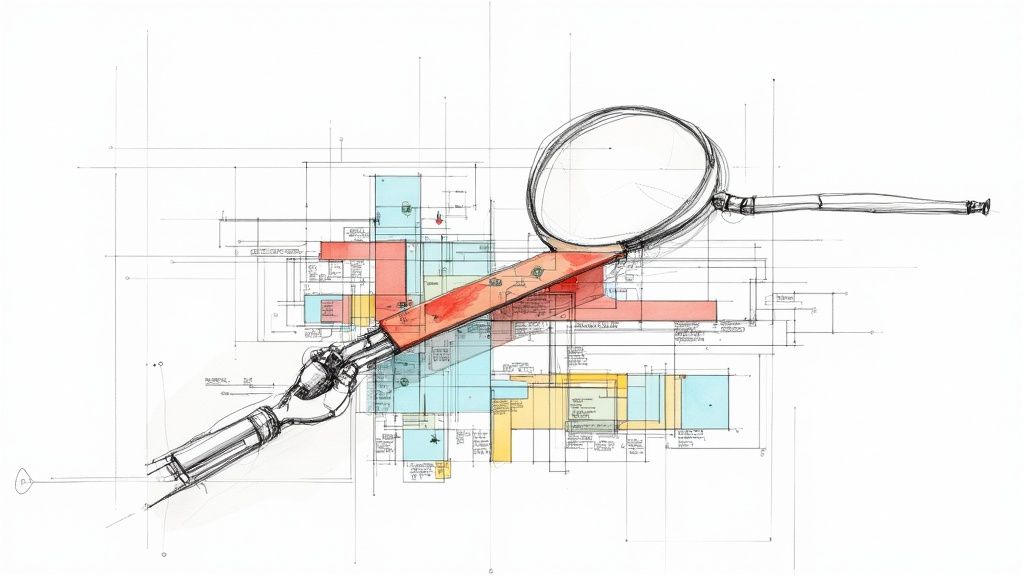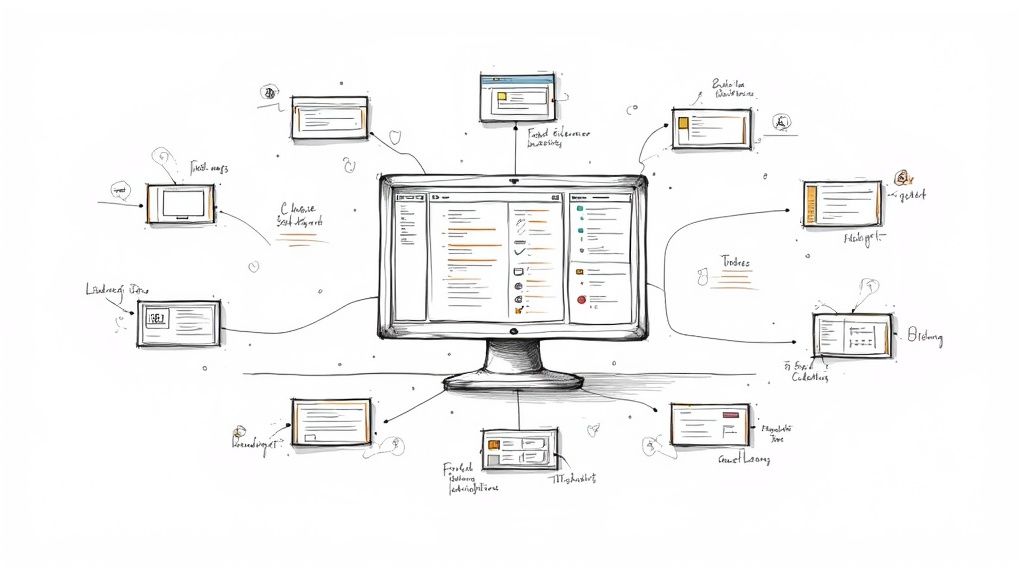Revolutionize Workflow with Pull Request Automation
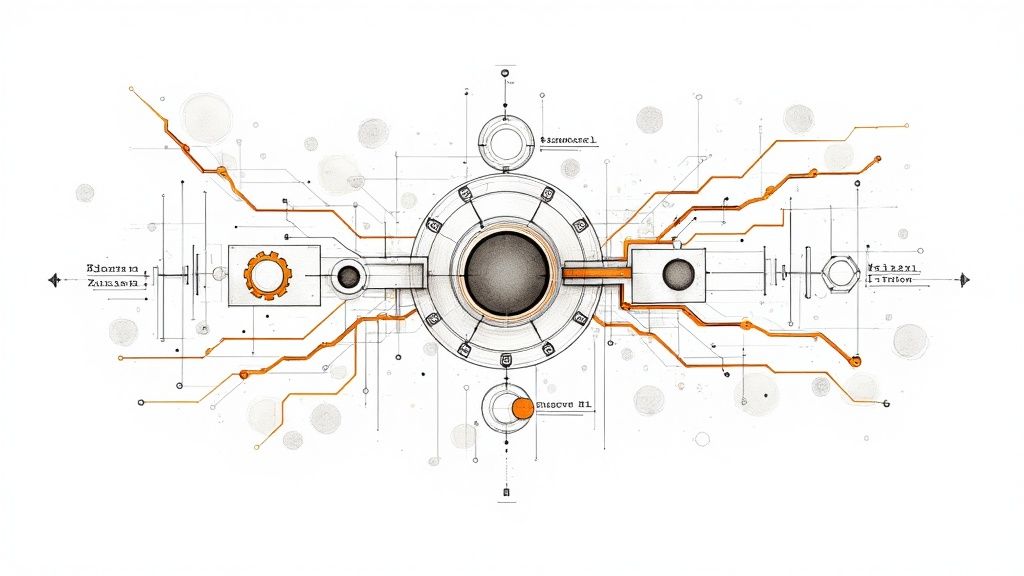
Breaking the Code Review Bottleneck

Manual code reviews are crucial for maintaining high code quality. However, they can become a significant bottleneck in the development process. These reviews are often time-consuming, susceptible to human error, and divert developers from building new features. This is where pull request automation offers a solution.
By automating repetitive tasks within the code review process, teams can significantly boost efficiency and speed up development cycles. This results in a more streamlined workflow, faster releases, and a more positive developer experience.
For example, many teams grapple with enforcing coding style guidelines and maintaining sufficient test coverage. These tasks are ideal candidates for automation. Tools like Mergify can automatically check pull requests against pre-defined style guides and confirm that all tests have passed before allowing a merge.
This automation removes the burden from human reviewers and ensures consistent standards across the entire codebase. It also prevents simple errors from being overlooked, resulting in more robust and dependable code.
Streamlining the Review Process With Automation
Pull request automation encompasses a variety of tools and techniques applicable to different stages of the code review process. These automated processes free up valuable developer time, allowing them to focus on more complex tasks. Ultimately, this contributes to a higher overall quality of code.
Here are some key areas where automation can provide immediate benefits:
- Automated Style Checks: Consistent coding style is vital for readability and maintainability. Automated tools can enforce style guidelines across the codebase, guaranteeing that every pull request adheres to established standards.
- Test Verification: Automated testing is essential for catching bugs early. Pull request automation can trigger automated tests and prevent merges if tests fail, ensuring that only functioning code is integrated.
- Quality Enforcement: Define specific quality metrics, such as code complexity or duplication, and automate checks to ensure these standards are met. This practice leads to better code quality and reduces technical debt.
This approach allows human reviewers to focus on higher-level considerations, like architecture, logic, and overall design. Pull requests have become a cornerstone of collaborative software development. In fact, research from 2023 analyzing over 3,347,937 pull requests across 11,230 projects highlighted the influence of context on pull request decisions. Explore this research further. Automation can enhance decision-making in this area by providing clear insights into relevant pull request metrics.
Moving Towards Intelligent Systems
Teams are shifting from manual, error-prone review processes to more intelligent systems that empower developers to address complex challenges. Automated systems offer several advantages over manual reviews.
They not only minimize human error but also offer a more consistent and objective evaluation of code changes. This consistency is especially important in large teams or projects where maintaining a uniform codebase is paramount.
Furthermore, automation enables faster feedback loops, significantly accelerating the development process. This rapid feedback leads to more efficient iterations and quicker identification and resolution of issues. By strategically implementing pull request automation, teams can optimize their workflows and achieve significant improvements in both development speed and code quality.
Real ROI: What Teams Actually Gain From Automation
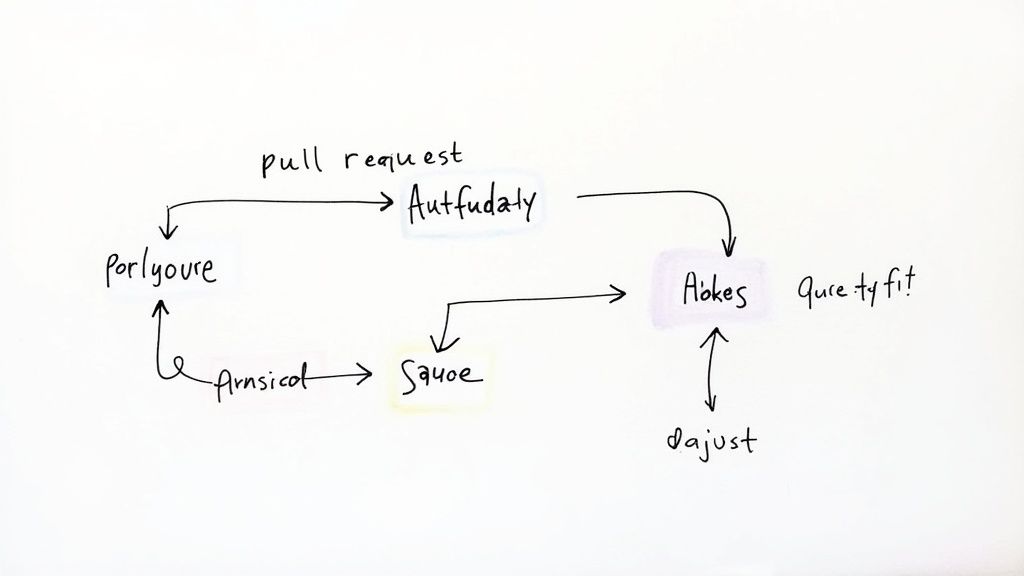
Pull request automation offers substantial benefits for engineering teams. It's more than just a way to speed things up; it directly tackles common issues that affect developer productivity, code quality, and team morale. By implementing pull request automation strategically, teams can see a significant return on investment.
One major advantage is the substantial reduction in review fatigue. In busy environments, manual code reviews can overwhelm reviewers with the sheer volume of changes. This fatigue can lead to missed errors and slower review cycles. Automation handles repetitive tasks, letting reviewers focus on high-level code aspects.
Automation also significantly reduces merge delays. Waiting for manual approvals and checks can slow down the development process. Automated checks and approvals, based on pre-defined conditions, streamline merging and enable continuous integration and continuous delivery (CI/CD). This faster turnaround means quicker feature releases and a more agile development lifecycle.
Automated tools also maintain consistent quality standards across the codebase. Manual checks are inconsistent and prone to human error. Automating style guidelines, testing procedures, and other quality metrics enforcement ensures every piece of code meets established standards.
Studies have shown varied results on the impact of automated tools on pull request efficiency. Sometimes, introducing these tools increased the average pull request closure duration. In other projects, it decreased significantly. These differences highlight the importance of adapting automation tools to specific development environments. More detailed statistics can be found here: https://arxiv.org/html/2412.18531v1
To further illustrate the potential ROI of pull request automation, let's examine some key metrics across different team sizes:
The following table, "Pull Request Automation ROI Metrics", highlights key metrics before and after implementing pull request automation across different organization sizes. This comparison reveals the potential gains in efficiency and speed.
| Metric | Small Teams (Before) | Small Teams (After) | Enterprise (Before) | Enterprise (After) |
|---|---|---|---|---|
| Average Review Time (hours) | 4 | 2 | 8 | 3 |
| Merge Cycle Time (days) | 3 | 1 | 5 | 2 |
| Bugs Found Post-Release | 15 | 5 | 50 | 20 |
As the table demonstrates, both small teams and large enterprises experience significant improvements after implementing pull request automation. Reduced review times, faster merge cycles, and fewer post-release bugs all contribute to a more efficient and effective development process.
Enhancing Developer Satisfaction and Transparency
Beyond the technical benefits, pull request automation improves developer well-being. Freed from tedious manual tasks, developers experience higher job satisfaction and can focus on more challenging and rewarding work. This boosts morale, increases productivity, and reduces employee churn.
Automation also increases transparency in the development process. Standardized, automated feedback eliminates ambiguity and ensures consistent guidance for all developers, leading to a more collaborative and constructive review environment.
More information on related topics can be found here: How to master...
Quantifying the Impact of Automation
The benefits of pull request automation can be measured concretely. Metrics like reduced review time, faster merge cycles, and decreased bug rates offer quantifiable proof of automation's positive impact. This data is crucial for demonstrating the ROI of automation initiatives to stakeholders and justifying further investment in streamlining development. By tracking progress with appropriate metrics, teams can continuously refine their automation strategies for maximum impact.
AI-Powered Reviews: Beyond Basic Automation

Pull request automation is rapidly changing. It's moving beyond simple, rule-based systems. The next generation of tools uses the power of artificial intelligence (AI) and machine learning (ML) to analyze code in new ways. This creates opportunities to improve code quality, speed up reviews, and empower developers.
Intelligent Code Analysis and Bug Detection
AI-powered tools are getting better at understanding code patterns and finding potential bugs. This is a big step forward from traditional static analysis. ML models can learn from massive codebases, finding subtle issues that human reviewers might miss.
For example, they can identify possible security flaws or highlight code that might cause maintenance headaches later on. AI can also provide smart recommendations for improving code. This turns pull requests into learning experiences, with AI insights adding to human expertise.
In some situations, these AI-driven suggestions can be as helpful as the feedback from senior developers. This helps less experienced team members write cleaner, more efficient code.
Automating Pull Request Summaries
A particularly useful application of AI in pull request automation is using transformer-based models. These models excel at understanding both natural language and code. This allows them to create short, accurate summaries of pull request changes.
This automation makes things much easier for human reviewers. Instead of carefully studying every single line of code, reviewers can quickly understand the main changes through the AI-generated summary. Automating pull requests is becoming crucial for efficient software development.
In fact, AI-powered code reviews are becoming more popular. Tools are now using transformer-based models to automatically summarize pull requests, lessening the workload on human reviewers. You can learn more about AI-powered pull requests here: AI-Powered Pull Requests. This lets reviewers focus on bigger-picture things like architecture, logic, and overall design. Combining AI and human expertise allows for faster, more thorough reviews.
The Role of Human Expertise
Even with the impressive abilities of AI, human oversight is still crucial. Current AI tools are best suited for specific, well-defined tasks. They're great at finding inconsistencies in style, enforcing coding standards, and catching common vulnerabilities.
However, they're not as good at understanding the complexities of large codebases or judging code based on broader business needs. The best teams find the right balance between AI-powered automation and human skills. They use AI for routine checks. This frees up human reviewers to focus on parts of the code review that require critical thinking and good judgment.
This collaborative approach makes pull requests efficient and effective. The result? Higher-quality code and faster development cycles.
Building Your Automation Pipeline From Scratch
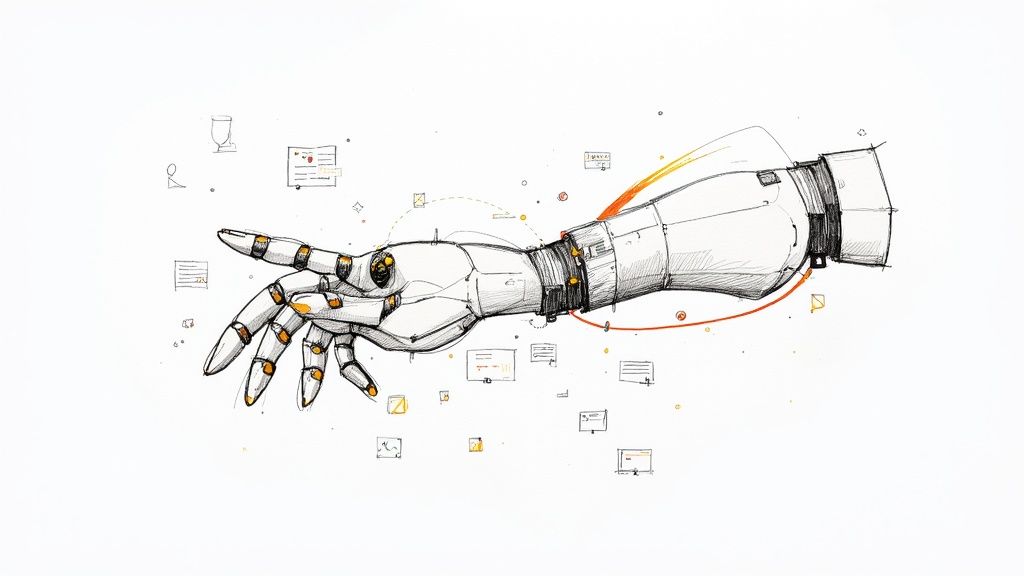
Building a pull request automation pipeline is key to improving your team's workflow. It's not a one-size-fits-all process. Your automation strategy should be tailored to your team's size, the specific technologies you use, and your overall quality objectives. This guide will help you build a practical and effective pipeline.
Choosing The Right Automation Tools
The first step is choosing the right tools. There are many options, each with its own strengths. Some tools specialize in particular tasks like style checking or testing, while others provide broader solutions. Mergify, for example, excels at automating complex merge workflows and managing multiple pull requests.
Think about your existing workflow and pinpoint the major challenges. Are you dealing with inconsistent coding styles? Are slow code reviews holding up releases? Selecting tools that directly address these problems will result in the most significant improvements.
Before diving into specific tools, let's consider some popular options available. The table below provides a comparison to help you choose the right one for your needs.
To help in this decision-making process, the following table compares some popular choices:
Popular Pull Request Automation Tools Comparison This table compares key features, integration capabilities, and pricing of leading pull request automation solutions.
| Tool Name | Core Features | Integration Capabilities | Pricing Model | Best For |
|---|---|---|---|---|
| GitHub Actions | CI/CD, automated workflows | GitHub, various third-party tools | Free tier, paid plans | Teams already using GitHub |
| GitLab CI/CD | CI/CD, automated testing, deployment | GitLab, other Git repositories | Free tier, paid plans | DevOps and CI/CD focused teams |
| CircleCI | CI/CD, cloud-based automation | GitHub, Bitbucket, other Git repositories | Free tier, paid plans | Cloud-native and cross-platform projects |
| Travis CI | CI/CD, testing and deployment | GitHub, other Git repositories | Free tier, paid plans | Open-source and enterprise projects |
| Mergify | Automated merge queue, complex merge strategies | GitHub | Paid plans | Teams with complex merge workflows |
This comparison highlights the variety of tools available. Choosing the right tool depends on your specific needs and existing workflows.
Configuring Automated Checks
After selecting your tools, you need to configure automated checks. These checks ensure every pull request meets your standards. Here's a breakdown of common automated checks:
- Style Consistency: Use linters and formatters to ensure a consistent coding style. This improves readability and cuts down time spent on style discussions during reviews.
- Test Coverage: Incorporate automated tests to confirm that code changes don't create regressions. This maintains code quality and reduces the chances of shipping software with bugs.
- Performance Benchmarks: Establish performance baselines and automate measuring the performance effect of code changes. This helps identify performance regressions early on.
- Security Vulnerabilities: Use automated security scanning to detect potential vulnerabilities in the early stages of development. Tools that scan for common security issues are a great way to implement this.
Begin with a few vital checks and gradually incorporate more as your team gets accustomed to the automation. A step-by-step process makes adoption easier and gives your team time to adapt.
Gradual Implementation and Team Training
Successfully implementing pull request automation requires a gradual, phased approach. Begin by automating simple checks like style enforcement or basic testing. This lets your team get used to the new process without feeling overwhelmed.
As your team gets more comfortable, introduce more sophisticated automation, such as automated merge approvals based on pre-defined conditions. Regularly assess how effective your automation rules are and adjust as needed. This iterative approach ensures that your automation continues to align with your team’s evolving needs.
Training is also crucial. Provide clear documentation and workshops to explain the new automated workflows. Make sure your team understands the benefits of automation and how it can simplify their work.
Measuring Success and Continuous Improvement
Tracking the impact of your pull request automation is important. Monitor metrics such as average review time, merge cycle time, and number of bugs found post-release. These metrics provide concrete evidence of improvements and can help you identify where to further optimize your automation.
Pull request automation isn't a set-it-and-forget-it system. It requires constant observation and fine-tuning. Review your automation rules regularly and adjust them based on team feedback and the collected data. This iterative process makes sure your pull request automation stays efficient and delivers continuous value.
Human + Machine: Creating the Perfect Review Balance
Finding the perfect balance between automated efficiency and human insight is crucial for effective pull request automation. The goal isn't to replace developers with automated systems, but to empower them to concentrate on what they excel at: creating innovative, high-quality code. Strategically integrating automation allows us to free human reviewers from repetitive tasks, enabling them to focus on more complex aspects of the codebase.
Defining the Roles: Automation vs. Human Oversight
Successfully balancing automation and human review requires a clear understanding of each one's responsibilities. Some aspects of the review process are perfectly suited for automation, while others require the nuanced judgment of a human reviewer. Still others benefit from a combined approach.
- Fully Automated Checks: Tasks like verifying coding style, ensuring sufficient test coverage, and enforcing basic quality metrics are ideal for automation. Tools like Mergify excel at streamlining these repetitive checks, ensuring consistent standards without human intervention. This allows developers to focus on more challenging and creative work.
- Human-Led Reviews: Architectural decisions, complex business logic, security considerations, and usability assessments all demand critical thinking and human insight. Experienced developers are best equipped to handle these tasks, as they can evaluate the code's impact on the larger system and business objectives.
- Collaborative Review: Some aspects benefit from a combined approach. For instance, AI-powered tools can identify potential bugs or suggest optimizations, which human reviewers can then evaluate and implement. This synergy combines the precision of automated analysis with the contextual awareness of a developer.
Guiding Human Reviewers Towards Strategic Contributions
One of the primary goals of pull request automation is to enable human reviewers to focus on high-level contributions. Automating routine checks allows developers to dedicate their time to:
- Architectural Design: Human reviewers can concentrate on ensuring the code aligns with the overall system architecture, promoting scalability and maintainability.
- Business Logic Validation: Developers can thoroughly evaluate whether the code effectively implements the intended business logic and meets user requirements.
- Mentorship and Knowledge Sharing: Senior developers can use code reviews as opportunities to mentor junior team members, ensuring adherence to best practices and providing valuable insights into the codebase.
This emphasis on higher-level aspects not only improves code quality but also fosters a more collaborative and supportive development environment. You might be interested in: How to master...
Addressing Challenges in Hybrid Review Environments
Integrating automation into existing workflows presents unique challenges. One common concern is maintaining critical thinking skills when many tasks are automated. To address this, teams should focus on:
- Regularly Reviewing Automation Rules: Automation rules should be reviewed and updated periodically to reflect evolving codebase standards and best practices. This prevents automation from becoming outdated and ensures it continues to support the team’s objectives.
- Encouraging Active Engagement with Automated Feedback: Developers should be encouraged to understand the rationale behind automated suggestions and flags, instead of passively accepting them. This promotes a deeper understanding of the code and reinforces critical thinking skills.
- Providing Opportunities for Skill Development: Allocate time for developers to improve their skills in areas that automation can't replace, such as architectural design and complex problem-solving. This ensures that human expertise remains a core strength of the team.
By proactively addressing these challenges, teams can effectively utilize pull request automation while preserving the essential element of human judgment and critical thinking. This collaborative partnership between humans and machines is the key to a more efficient, effective, and rewarding development process.
The Future of Pull Request Workflows
The world of pull requests is constantly evolving. New technologies are reshaping how development teams manage code contributions. This shift is driven by the need for faster releases, higher quality code, and more efficient team collaboration. Understanding these trends is key to staying ahead and preparing for the future of development.
AI-Powered Insights and Intelligent Suggestions
Artificial intelligence (AI) is creating powerful tools that go beyond simple automation. These tools can understand code changes, predict potential problems, and offer helpful suggestions. This means pull request automation is no longer limited to basic checks like style and tests.
For example, AI can analyze code for potential bugs or security vulnerabilities. Some tools use transformer-based models) to summarize pull request changes, making reviews easier. This lets human reviewers focus on bigger picture items like architecture and design.
AI is also being used to predict maintenance issues and suggest optimizations proactively. This helps teams avoid technical debt and keep a cleaner codebase. You might be interested in: How to master...
Streamlining Review Processes With Automated Code Generation
Emerging trends combine automated code generation with streamlined reviews. Imagine AI analyzing code and generating snippets or even entire functions based on the pull request. This could drastically speed up development and reduce manual coding time.
While still experimental, these approaches could change how developers contribute. By automating repetitive tasks, developers can focus on complex problem-solving and innovation.
Optimizing Developer Productivity Through Workflow Analytics
Leading organizations use workflow analytics to understand their development processes. By tracking metrics like review time, merge cycle time, and revisions per pull request, teams can find bottlenecks and areas to improve.
This data-driven approach helps teams optimize developer productivity and maintain code quality. For example, if analytics show a certain type of pull request always needs many revisions, the team can investigate and streamline the process.
Preparing for the Next Generation of Development
These trends show a future where pull request automation is deeply integrated with AI and intelligent workflows. Teams that use these technologies will be better prepared for the growing complexity of software development. By combining human expertise with automated tools, organizations can achieve faster releases, better code, and happier developers.
Ready to improve your pull request workflow and experience the benefits of automated code integration? Mergify offers a powerful platform for managing complex merge workflows, lowering CI costs, and improving code security. Learn more at Mergify.



